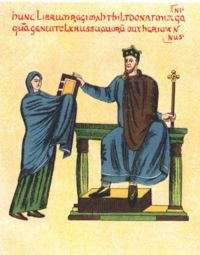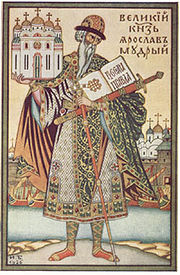
Treaty of Merseburg
Encyclopedia
The Treaty of Merseburg of 1033 was an agreement between the Salian
Holy Roman Emperor
Conrad II
on one side, and the Piast
king of Poland Mieszko II which settled the question of Polish succession which had been contested between Mieszko and his half-brothers Bezprym
, Otto, and Dietric, since the death of Bolesław I Chrobry. Poland was divided into three parts with Mieszko designated as the supreme ruler. In exchange for the Emperor's support however, Mieszko was forced to renounce the title of king, which had been acquired in 1025 by his father and give up control over Lusatia
and Upper Lusatia
. Soon after the treaty was concluded however, Otto died of natural causes and Mieszko prevented Dietric from assuming power in his portion of the divided Poland. Mieszko also subsequently continued to use the title of king until his death shortly after the treaty in 1034.
 The Emperor Henry II was succeeded by Conrad II
The Emperor Henry II was succeeded by Conrad II
, while Boleslaw I, who had crowned himself King of Poland two months before Henry's death (1025), was succeeded by Mieszko II. In 1028, Mieszko II attacked the eastern marches of Saxony
. As a consequence, the see of the Bishopric of Zeitz was relocated to the more secure Naumburg
, and Conrad II launched several counter-attacks. Mieszko II avoided open battle and withdrew into difficult terrain, namely forrests nearly impassable for the heavy German cavalry. Conrad II was supported by Olrich (Udalrich) of Bohemia, who in the course of the 1029 campaign gained Moravia
.
In 1030, Mieszko II again raided the eastern marches, but in 1031 was repulsed by Conrad II and forced to make peace. In the agreement, Mieszko II renounced his claims to the Lusatian march and Upper Lusatia
.
 After the peace of Bautzen (1031), Yaroslav I of Kiev attacked Miesko II from the east. Yaroslav I had supported Mieszko II's older half-brother Bezprym in the succession of Boleslaw I, and granted him refuge at his court when Mieszko II had assumed power. With Yaroslav I's support, Bezprym ousted Miesko II, but was murdered in 1032, most likely on account of his cruelty and brutal suppression of noble's opposition. In contrast to his half-brother, Bezprym had not taken on the title of a Polish king in order to gain support from Conrad II, and even sent the Polish royal insignia to the emperor. After Bezprym's death, Conrad's wife, Empress Gisela, as well as several German nobles interceded on Mieszko's behalf and he returned to power, and attended a Hoftag in Merseburg in 1033.
After the peace of Bautzen (1031), Yaroslav I of Kiev attacked Miesko II from the east. Yaroslav I had supported Mieszko II's older half-brother Bezprym in the succession of Boleslaw I, and granted him refuge at his court when Mieszko II had assumed power. With Yaroslav I's support, Bezprym ousted Miesko II, but was murdered in 1032, most likely on account of his cruelty and brutal suppression of noble's opposition. In contrast to his half-brother, Bezprym had not taken on the title of a Polish king in order to gain support from Conrad II, and even sent the Polish royal insignia to the emperor. After Bezprym's death, Conrad's wife, Empress Gisela, as well as several German nobles interceded on Mieszko's behalf and he returned to power, and attended a Hoftag in Merseburg in 1033.
There, Mieszko II renounced claims to the Lusatian march and Upper Lusatia (Milzenerland), and renounced claims to the title of a king. Henry II divided Poland into three parts, giving Silesia to Mieszko's half brother Otto, while his other half brother, Dietric (Boguslaw), most likely received Western Pomerania. but confirmed Miezko II’s superiority over these. However, in the same year Otto died of natural causes and Mieszko successfully prevented Dietric from assuming power in Pomerania, thus reuniting the core of Polish lands. He also continued to use the title of king, despite the agreement at Merseburg and Polish documents of the time referred to him as such.
However Mieszko II died soon after in 1034, and upon his death a Pagan reaction in Poland
erupted (although some aspects of it were present earlier and contributed to Mieszko's difficulties in dealing with Conrad and Yaroslav). Subsequently, his wife Richeza as well as his son Casimir I
fled to Germany.
Salian dynasty
The Salian dynasty was a dynasty in the High Middle Ages of four German Kings , also known as the Frankish dynasty after the family's origin and role as dukes of Franconia...
Holy Roman Emperor
Holy Roman Emperor
The Holy Roman Emperor is a term used by historians to denote a medieval ruler who, as German King, had also received the title of "Emperor of the Romans" from the Pope...
Conrad II
Conrad II, Holy Roman Emperor
Conrad II was Holy Roman Emperor from 1027 until his death.The son of a mid-level nobleman in Franconia, Count Henry of Speyer and Adelaide of Alsace, he inherited the titles of count of Speyer and of Worms as an infant when Henry died at age twenty...
on one side, and the Piast
Piast dynasty
The Piast dynasty was the first historical ruling dynasty of Poland. It began with the semi-legendary Piast Kołodziej . The first historical ruler was Duke Mieszko I . The Piasts' royal rule in Poland ended in 1370 with the death of king Casimir the Great...
king of Poland Mieszko II which settled the question of Polish succession which had been contested between Mieszko and his half-brothers Bezprym
Bezprym
Bezprym was a Duke of Poland during 1031–1032.He was the eldest son of Bolesław I the Brave, King of Poland, but was deprived of the succession by his father, who around 1001 sent him to Italy, in order to became a monk at one of Saint Romuald's hermitages in Ravenna.Expelled by his half-brother...
, Otto, and Dietric, since the death of Bolesław I Chrobry. Poland was divided into three parts with Mieszko designated as the supreme ruler. In exchange for the Emperor's support however, Mieszko was forced to renounce the title of king, which had been acquired in 1025 by his father and give up control over Lusatia
Lusatia
Lusatia is a historical region in Central Europe. It stretches from the Bóbr and Kwisa rivers in the east to the Elbe valley in the west, today located within the German states of Saxony and Brandenburg as well as in the Lower Silesian and Lubusz voivodeships of western Poland...
and Upper Lusatia
Upper Lusatia
Upper Lusatia is a region a biggest part of which belongs to Saxony, a small eastern part belongs to Poland, the northern part to Brandenburg. In Saxony, Upper Lusatia comprises roughly the districts of Bautzen and Görlitz , in Brandenburg the southern part of district Oberspreewald-Lausitz...
. Soon after the treaty was concluded however, Otto died of natural causes and Mieszko prevented Dietric from assuming power in his portion of the divided Poland. Mieszko also subsequently continued to use the title of king until his death shortly after the treaty in 1034.
Background

Conrad II, Holy Roman Emperor
Conrad II was Holy Roman Emperor from 1027 until his death.The son of a mid-level nobleman in Franconia, Count Henry of Speyer and Adelaide of Alsace, he inherited the titles of count of Speyer and of Worms as an infant when Henry died at age twenty...
, while Boleslaw I, who had crowned himself King of Poland two months before Henry's death (1025), was succeeded by Mieszko II. In 1028, Mieszko II attacked the eastern marches of Saxony
Duchy of Saxony
The medieval Duchy of Saxony was a late Early Middle Ages "Carolingian stem duchy" covering the greater part of Northern Germany. It covered the area of the modern German states of Bremen, Hamburg, Lower Saxony, North Rhine-Westphalia, and Saxony-Anhalt and most of Schleswig-Holstein...
. As a consequence, the see of the Bishopric of Zeitz was relocated to the more secure Naumburg
Naumburg
Naumburg is a town in Germany, on the Saale River. It is in the district Burgenlandkreis in the Bundesland of Saxony-Anhalt. It is approximately southwest of Leipzig, south-southwest of Halle, and north-northeast of Jena....
, and Conrad II launched several counter-attacks. Mieszko II avoided open battle and withdrew into difficult terrain, namely forrests nearly impassable for the heavy German cavalry. Conrad II was supported by Olrich (Udalrich) of Bohemia, who in the course of the 1029 campaign gained Moravia
Moravia
Moravia is a historical region in Central Europe in the east of the Czech Republic, and one of the former Czech lands, together with Bohemia and Silesia. It takes its name from the Morava River which rises in the northwest of the region...
.
In 1030, Mieszko II again raided the eastern marches, but in 1031 was repulsed by Conrad II and forced to make peace. In the agreement, Mieszko II renounced his claims to the Lusatian march and Upper Lusatia
Upper Lusatia
Upper Lusatia is a region a biggest part of which belongs to Saxony, a small eastern part belongs to Poland, the northern part to Brandenburg. In Saxony, Upper Lusatia comprises roughly the districts of Bautzen and Görlitz , in Brandenburg the southern part of district Oberspreewald-Lausitz...
.
Merseburg (1033)

There, Mieszko II renounced claims to the Lusatian march and Upper Lusatia (Milzenerland), and renounced claims to the title of a king. Henry II divided Poland into three parts, giving Silesia to Mieszko's half brother Otto, while his other half brother, Dietric (Boguslaw), most likely received Western Pomerania. but confirmed Miezko II’s superiority over these. However, in the same year Otto died of natural causes and Mieszko successfully prevented Dietric from assuming power in Pomerania, thus reuniting the core of Polish lands. He also continued to use the title of king, despite the agreement at Merseburg and Polish documents of the time referred to him as such.
However Mieszko II died soon after in 1034, and upon his death a Pagan reaction in Poland
Pagan reaction in Poland
The Pagan reaction in Poland was a series of events in the Kingdom of Poland of the 1030s that culminated in a popular uprising. It was caused by dissatifaction with the economic situation and with the process of Christianization.-See also:...
erupted (although some aspects of it were present earlier and contributed to Mieszko's difficulties in dealing with Conrad and Yaroslav). Subsequently, his wife Richeza as well as his son Casimir I
Casimir I of Poland
Casimir I the Restorer , was a Duke of Poland of the Piast dynasty and the de facto monarch of the entire country from 1034 until his death....
fled to Germany.

